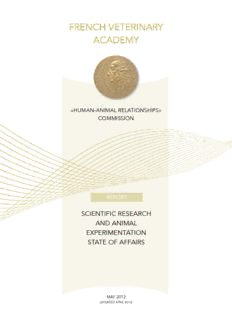
GIRCOR RAPPORT ACADEMIE VETERINAIRE DE FRANCE ANGLAIS V3_Mise en page 1 PDF
Preview GIRCOR RAPPORT ACADEMIE VETERINAIRE DE FRANCE ANGLAIS V3_Mise en page 1
FRENCH VETERINARY ACADEMY «HUMAN-ANIMAL RELATIONSHIPS» COMMISSION REPORT SCIENTIFIC RESEARCH AND ANIMAL EXPERIMENTATION STATE OF AFFAIRS MAY 2012 (UPDATED APRIL 2013) FRENCH VETERINARY ACADEMY «HUMAN-ANIMAL RELATIONSHIPS» COMMISSION REPORT SCIENTIFIC RESEARCH AND ANIMAL EXPERIMENTATION STATE OF AFFAIRS 1 2 SCIENTIFIC RESEARCH AND ANIMAL EXPERIMENTATION STATE OF AFFAIRS COMPOSITION AND VALIDATION OF THE REPORT “Scientific research and animal experimentation State of affairs” This report has been drawn up within the framework of a general study carried out by the Commission for «Human-Animal relationships» of the French Veterinary Academy. It was conceived and coordinated by Claude Milhaud. Editorial contributions from : Henri Brugère, Bertrand Deputte, Agnès Fabre, Jean Kahn, Yves Le Floc’h Soye, Henri Maurin-Blanchet, Claude Milhaud, members of the Commission for «Human-Animal relationships» of the French Veterinary Academy. The editors of this report thank the members of the «Research and Education» Department of the French Veterinary Academy : Hervé Bazin, Claude Carnaud, Michel Fougereau, Jean-Louis Guénet, Dominique Kerbœuf, Jean-Paul Laplace, Charles-Henri Malbert, Pierre Mormède, Gérard Orth, André Parodi, Charles Pilet, Serge Rosolen, Jean-Paul Rousseau, Michel Thibier, for their well-informed and judicious advice during the project review of the report. The conclusion of the report is presented as a recommendation submitted for consideration to and adopted by the General Assembly of the French Veterinary Academy on June 21st 2012. 3 4 SCIENTIFIC RESEARCH AND ANIMAL EXPERIMENTATION STATE OF AFFAIRS SUMMARY CONTENTS 9 ...................................................................................................................................................................................................................... INTRODUCTION 13 ........................................................................................................................................................................................................ CHAPTER I : A SOCIAL DEBATE 1) Biomedical research : a necessity for society 15 ....................................................................................................................... 2) Animal experimentation : foundation of a scientific approach to health 15 ............................................. 2.1) Historical overview 15 ....................................................................................................................................................................... 2.2) Quantitative importance of research using animals 19 ............................................................................... 2.3) Regulatory framework 20 .............................................................................................................................................................. 2.4) Unanimity of research organizations 21 ........................................................................................................................ 2.5) Additional problem of the use of live animals for educational purposes 21 ...................... 3) Opposition to animal experimentation 22 ...................................................................................................................................... 3.1) A social issue 22 ...................................................................................................................................................................................... 3.2) Nature and methods of the opposition to animal experimentation 22 ................................... 3.2.1) Global opinion sincerity 22 ........................................................................................................................................ 3.2.2) Philosophical opposition : current trends 23 ......................................................................................... 3.2.3) Opposing associations 23 ........................................................................................................................................... 3.2.4) Radical opposition 24 ...................................................................................................................................................... 3.2.5) Methodological opposition 24 .............................................................................................................................. 4 ) Position of the researchers 24 ...................................................................................................................................................................... 4.1) Evolution : discretion in communication 24 ............................................................................................................. 4.2) Current organization of considerations regarding animal experimentation 25 ............... 4.2.1) Among the research organizations 25 .......................................................................................................... 4.2.2) The professional associations 25 ......................................................................................................................... 4.2.3) Education : spontaneous initiatives, regulatory training 25 ................................................ 4.2.4) Self-regulation : the ethics 26 ................................................................................................................................. 4.2.5) Official organizations 26 ................................................................................................................................................ 5) The controversy 27 ..................................................................................................................................................................................................... 5.1) Is there a rational basis on which to judge animal experimentation? 27 .................... 5.2) The answer from J. HABERMAS 27 ....................................................................................................................... 5.3) Rejection partially explained by non-disclosed big challenges and by certain failures 27 .................................................................................................................................................. 5.4) Societal incoherence 28 ..................................................................................................................................................... 5.5) Attitude of the members of Parliament 29 ................................................................................................... 5 SUMMARY CHAPTER II : ANIMAL MODELS AND SUBSTITUTIVE METHODS 1) Animal models 31 ........................................................................................................................................................................................................ 1.1) Complexity of organisms 31 ...................................................................................................................................................... 1.2) Ethical and scientific limits to the use of humans in biological and medical experiments 32 ..................................................................................................................................................... 1.3) Dual relationship with animals 32 ........................................................................................................................................ 1.4) Awareness of the limitations of animal models 33 ........................................................................................... 2) Use of animal models 34 ..................................................................................................................................................................................... 2.1) Animal models in basic research 34 .................................................................................................................................. 2.1.1) An example of experimental approach : the physiology of endocrine glands 34 ....................................................................................................... 2.1.2) Statement of researchers on the experimental approach 35 .............................................. 2.2) Animal models in applied research 36 .......................................................................................................................... 2.2.1) Medicine 36 ................................................................................................................................................................................ 2.2.2) Surgery 37 ..................................................................................................................................................................................... 2.2.3) Toxicology and safety of health products, pharmacology 38 ............................................. 2.3) Limitations to conditions of use 38 .................................................................................................................................... 2.3.1) Limitations to the number of animals used 38 .................................................................................... 2.3.2) Limitations to the distress imposed to the animals 39 ............................................................... 2.4) Economic and practical aspects 39 ................................................................................................................................... 3) Replacement methods 40 .................................................................................................................................................................................. 3.1) Introduction : replacement methods and alternative methods 40 ................................................ 3.2) European regulations : ECVAM («European Centre for Validation of Alternative Methods») 40 .................................. 3.3) Toxicology and safety of health products 41 .......................................................................................................... 3.4) Pharmacology 43 ................................................................................................................................................................................... 3.5) Monitoring efficacy and safety of immunological products 43 .......................................................... 3.6) Limitations of in vitro methods 43 ...................................................................................................................................... 3.6.1) Reminders 43 ............................................................................................................................................................................. 3.6.2) Reproducibility 44 ................................................................................................................................................................ 3.6.3) Duration of the validation process 44 ........................................................................................................... 3.7) Limitations of in silico methods 44 ..................................................................................................................................... 4) Synthetic or combinatorial approaches 45 ...................................................................................................................................... 5) Conclusions 46 ................................................................................................................................................................................................................ 6 SCIENTIFIC RESEARCH AND ANIMAL EXPERIMENTATION STATE OF AFFAIRS CHAPTER III : PRACTICE OF ANIMAL EXPERIMENTATION. BASES FOR AN ACADEMIC APPROACH 1) First basis : recourse to animal experimentation is indispensable 49 ............................................................. 2) Second basis : sentience and their biological proximity to humans imply that animals should be respected 50 ................................................................................................................................................... 2.1) Pain control 50 ........................................................................................................................................................................................ 2.2) Next to suppression of pain, limiting the recourse to live animals and ensuring their well-treatment form the bases of an ethical approach 51 ................ 2.2.1) the three «R»’s 51 ............................................................................................................................................................... 2.2.2) «Enrichment» 51 ................................................................................................................................................................... 2.2.3) Relation between benefits for humans / distress for animals 51 ................................... 2.2.4) The ethics committees 52 ......................................................................................................................................... The National Charter on the ethics of animal experimentation 52 ............................................. 2.2.5) The death of the laboratory animal 53 ....................................................................................................... 2.2.6) Rehabilitation or «Re-homing» the laboratory animal 54 ...................................................... 3) Third basis : rationality, objectivity and diversity dictate the experimental approach 54 ........................................................................................................................................................................... 4) Fourth basis: towards conciliation on the debate regarding animal experimentation through dialogue and mutual respect 55 ........................................................................................................................................ 4.1) Communication, one of the duties of the researcher 55 ......................................................................... 4.2) The duties of Society 56 ............................................................................................................................................................... 4.3) Favoring mutual listening 57 ................................................................................................................................................... CONCLUSION Recommendation of the French Veterinary Academy 59 ........................................................................... BIBLIOGRAPHY References quoted in the report 59 ..................................................................................................................................... 7 8
Description: